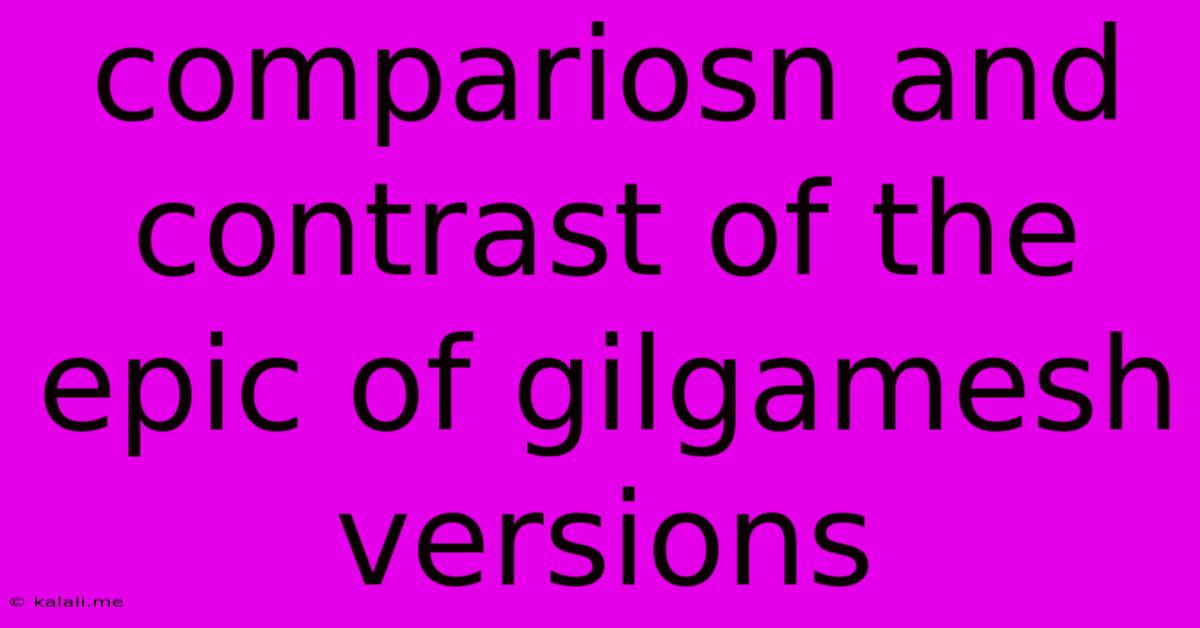Compariosn And Contrast Of The Epic Of Gilgamesh Versions
Kalali
Jun 03, 2025 · 3 min read

Table of Contents
Comparing and Contrasting Versions of the Epic of Gilgamesh: A Journey Through Time and Translation
The Epic of Gilgamesh, one of the oldest surviving works of literature, exists in numerous versions, each offering a unique perspective on this timeless tale of kingship, friendship, and mortality. This article delves into the key differences and similarities across these versions, exploring how variations in translation and discovery impact our understanding of this ancient epic. Understanding these nuances is crucial for appreciating the richness and complexity of the Gilgamesh narrative.
The Foundation: The Standard Babylonian Version
The most complete and widely studied version of the Epic of Gilgamesh is the Standard Babylonian version, dating back to the 13th century BC. This version, discovered on eleven clay tablets, provides a relatively coherent narrative, detailing Gilgamesh's reign, his friendship with Enkidu, their adventures, Gilgamesh's quest for immortality, and his ultimate acceptance of mortality. This version forms the bedrock for most modern translations and interpretations. It sets the stage for understanding the variations found in other versions.
Key Differences Across Versions:
Several significant differences emerge when comparing the Standard Babylonian version with other fragments and versions discovered across different time periods and geographical locations:
-
Length and Structure: The length and structural organization vary considerably. Some versions are fragmentary, lacking complete sections or containing rearranged episodes. This fragmentation significantly affects the narrative flow and the emphasis on particular themes. The Old Babylonian versions, for instance, are significantly shorter and less developed than the Standard Babylonian text.
-
Emphasis on Specific Themes: The degree of emphasis on certain themes, such as Gilgamesh's kingship, his relationship with the gods, or the exploration of immortality, shifts across different versions. Some versions focus more on Gilgamesh’s political achievements, while others emphasize his emotional journey and spiritual growth. This variance highlights the evolving societal values and beliefs reflected in the text over time.
-
Character Portrayals: While the core characters remain consistent – Gilgamesh, Enkidu, Ishtar, Utnapishtim – their portrayals can differ subtly or even substantially across different versions. Gilgamesh, for example, is sometimes portrayed as more arrogant and tyrannical in some versions, whereas others highlight his capacity for empathy and growth. Similarly, the nature of his relationship with Enkidu can be depicted with varying degrees of intensity and intimacy.
-
Linguistic and Stylistic Variations: The linguistic choices made by different scribes and translators inevitably lead to stylistic variations. These stylistic differences can affect the tone, rhythm, and overall readability of the epic. Furthermore, differing interpretations of ancient Sumerian and Akkadian words and phrases lead to nuances in meaning and translation choices that impact our modern understanding.
-
The Role of the Gods: The portrayal and involvement of the gods also demonstrate variability. Some versions highlight a more direct and interventionist role for the gods in Gilgamesh's life, while others show a more subtle influence, showcasing evolving religious beliefs and cosmological perspectives.
The Significance of Variances:
The existence of multiple versions of the Epic of Gilgamesh is not a sign of imperfection but rather a testament to its enduring power and its ability to adapt to changing cultural contexts across centuries. Studying these variations helps us:
-
Understand the Evolution of the Narrative: Comparing versions reveals the dynamic nature of oral tradition and the ways in which stories evolve and adapt over time. It shows how different scribes and audiences shaped and reshaped the story to fit their own perspectives and values.
-
Gain Deeper Insights into Ancient Mesopotamian Culture: Examining these diverse versions provides valuable insights into the beliefs, values, and social structures of ancient Mesopotamian civilizations across different periods.
-
Appreciate the Challenges of Translation: The discrepancies highlight the complexities and inherent challenges in translating ancient texts, revealing how translator's interpretations influence our modern understanding of the narrative.
Conclusion:
The variations in the surviving versions of the Epic of Gilgamesh enrich our understanding of this monumental work. By acknowledging and analyzing these differences, we can gain a far deeper and more nuanced appreciation for the epic's lasting legacy and its continuing relevance to modern audiences. While the Standard Babylonian version provides a foundational text, the other fragments offer invaluable complementary perspectives, enriching the tapestry of this ancient and fascinating narrative.
Latest Posts
Latest Posts
-
Convert Single Speed To Internal Gear Hub
Jun 05, 2025
-
Summoned To Another World Again Manga
Jun 05, 2025
-
Cannot Access To This Device Connected Device Needs
Jun 05, 2025
-
Eyes To See And Ears To Hear
Jun 05, 2025
-
Will Spearmint Come Back Every Year
Jun 05, 2025
Related Post
Thank you for visiting our website which covers about Compariosn And Contrast Of The Epic Of Gilgamesh Versions . We hope the information provided has been useful to you. Feel free to contact us if you have any questions or need further assistance. See you next time and don't miss to bookmark.